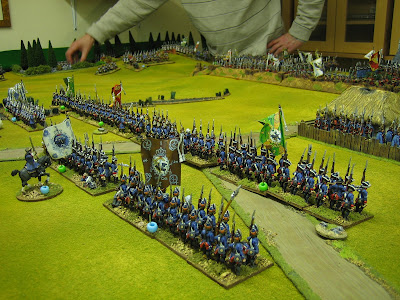Before I embark on the AAR, a little Blog News.
Last week I received some advance copies of Honours of War by Keith Flint. This is book 11 of the Osprey Wargame Rules series and covers the Seven Years War. I took some of the photos that feature in the book so I was looking forward to seeing how they turned out with some interest.
I've been buying Ospreys since the 1970s and it feels as though I've always had them kicking about the place. I even bought them in my late teens / early twenties, though I read them discreetly tucked between the pages of the NME, obviously. But I never, ever thought I would feature in one in any way - James Roach's stuff in an Osprey, who'd have guessed it?
Considering my photos were taken with an old Ixus 30 compact camera under household lighting I think they look rather good. In all, the book features 8 photographs of my SYW Prussians and Russians, including one on the back cover and one on the fly leaf (though one or two are 'repeats'). I'm also named a few times, which is all rather nice.
I hope this rule set goes down well and sells well: SYW is such a fantastic war game period. The rule book seems to be well written, laid out and presented and it doesn't have the ominous bulk of several sets of rules I've come across recently, or the bulky price tag that goes with them. From what I have gathered, from the rules and various forum posts, these rules are aimed at gamers with modest collections - I think they are aimed at scenarios with eight to a twenty units a side (guessing) - so they should be very useful for people just getting into the period.
At some point in the very near future I intend to give Honours of War a try out. I'll post an AAR when I do.
This photograph is probably my favourite, and I post it here to give you some idea of the photos by me in the book.
I haven't played with my Russians for some time, and seeing them 'in print' made me want to get them out for a game.
The AAR that follows charts the set up and first night's play. It is not an Honours of War game as I haven't had time to properly read the rules yet.
Here we see 26 units of Prussians lined up on their side of the valley. They are formed up in a typical deployment with infantry in the centre and cavalry on the wings. They will be the attackers and they have a surprise up their sleeve.
The 36 units of Russians formed up on their side of the valley. The Russians have thrown up earthworks to cover the slopes in front of the village (the game objective) and they have built a redoubt to fortify a farm at the foot of the slope. Their cavalry, Cossacks excepted are in reserve behind the flanks.
This is a strong position for the Russians, and they have stacks of troops to defend it with. On the right cavalry stands ready to sally out.
The centre and left of the Russian line. The left, though without earthworks is very strongly manned. A counter attack, if one comes, will probably start here.
The entrenchments bristle with cannon and muskets.
The fortified farm below the main entrenchments might prove very useful as a breakwater.
The Prussian right: infantry cavalry and guns, though not in any great numbers compared to their opposition in this sector of the field.
The Prussian centre partly deployed on the reverse slopes. This sector is furnihed with an abundance of heavy artillery and some howitzers.
The Prussian mission is easy. March across that valyey and take the village with it's dominating church.
After dicing up for unit and command quality and the briefest of briefings battle commenced.
The Battle started with a desultory by both sides, and with seemingly little effect.
Then the Prussians sprang their surprise.
Six more Prussian infantry units, half of them grenadiers, appeared on the Russian right flank. Only a bunch of ill disciplined Cossacks were immediately available to oppose them.
On their arrival the bulk of the Prussians in the centre went forward in support against the front of the Russian right and centre.
The Prussians, having taken a hail of shot and shell, break into the fortified village.
On the Russian left, as expected an attack, of sorts, starts to develop.
Graham H. has a love hate relationship with Cossacks. He loves them, Peter and I hate him for it. For some reason, unlike any historical SYW Russian commander, he always manages to get something out of them. It doesn't matter what rules I downgrade them with, Graham always gets something out of them.
On the Russian right the Prussian flank attack steps boldly forward.
The Cossacks don't hold up well and are soon put to ignominious flight, as is right and proper, but Graham has more Cossacks!
In the centre, the fortified village becomes a death trap to both sides.
At the end of the first nights play the centre and Prussian left were becoming engaged along their entire front.
On the Prussian right a Russian attack is just beginning to develop.
In mid shot you can see a bunch of hairy arsed Cossacks that have managed to 'heroically' charge across the front of a line of Prussian cavalry to chase off a bunch of gunners.
Fortunately for Peter, Graham has spent the bulk of his initiative points fighting on his right and little has been left to develop an attack in this sector.














































